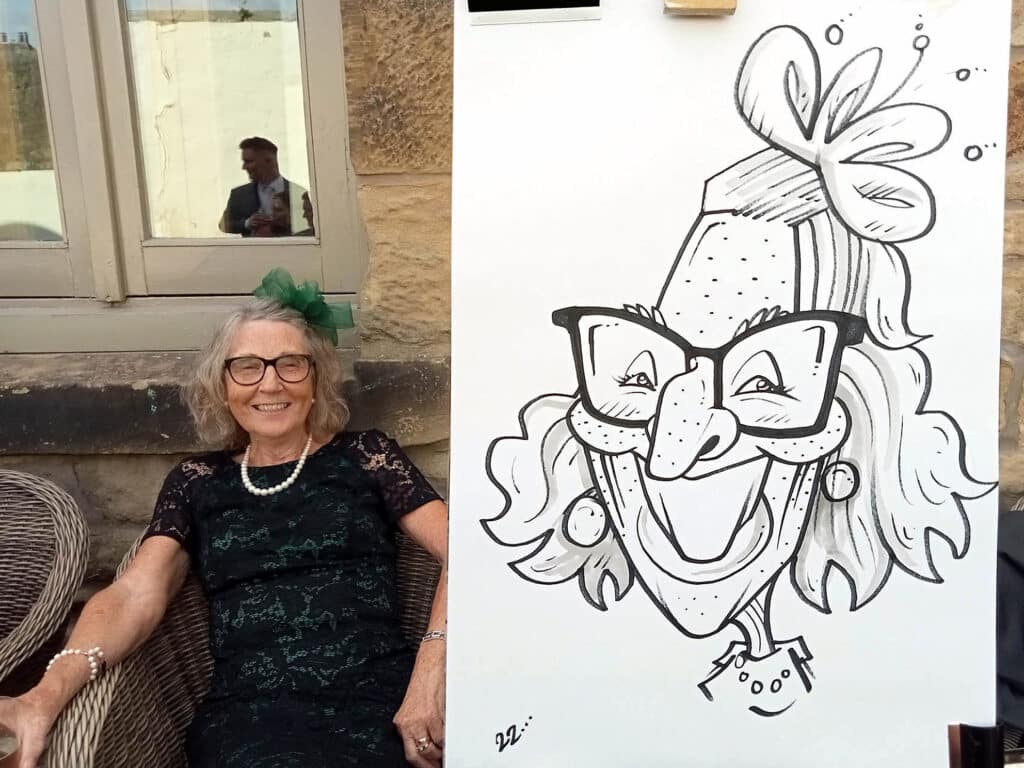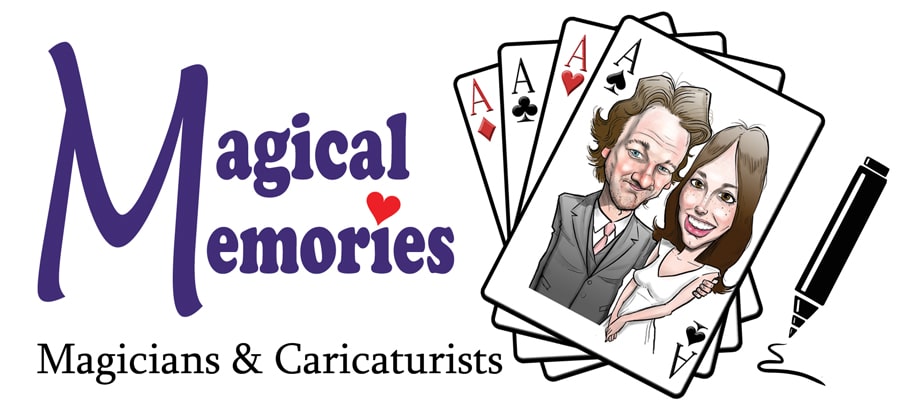
When hiring a caricaturist for your event, their portfolio is your window into their artistic style, skill level, and professionalism. A thoughtful review of an artist’s work can help you determine if they’re the right fit for your specific event needs. At Magical Memories, we represent a diverse range of talented professional caricaturists, each with their own unique style. This comprehensive guide will help you evaluate caricaturist portfolios effectively to ensure you select an artist whose work aligns with your vision.
Why Portfolio Evaluation Matters
A caricaturist’s portfolio reveals much more than just artistic style:
- Consistency: Can they maintain quality when working quickly at events?
- Versatility: Do they adapt well to different subjects and requirements?
- Likeness capture: How accurately do they represent their subjects?
- Experience level: Does their work demonstrate professional-level skill?
- Appropriateness: Is their style suitable for your specific event type?
Taking time to properly evaluate portfolios helps ensure you select an artist whose work aligns with your expectations and event needs.
Types of Portfolio Samples to Look For
Live Event Samples vs. Studio Work
A comprehensive portfolio should include both:
- Live event samples: Caricatures created at actual events under time constraints
- Studio work: More detailed pieces created without time pressure
Red flag: Portfolios containing only studio work may not represent what the artist can produce in a live event setting with time limitations.
Event-Specific Samples
Look for examples from events similar to yours:
- Corporate events if you’re planning a business function
- Weddings if you’re booking for a wedding
- Children’s parties if your event involves young guests
- Trade shows if you’re booking for an exhibition
These samples demonstrate the artist’s experience with your specific event type and audience.
Before/After Comparisons
Valuable portfolio elements include:
- Photographs of subjects alongside their caricatures
- Videos showing the drawing process from start to finish
- Multiple examples of the same subject drawn in different styles
These comparisons help you assess how the artist interprets real people and their level of likeness capture.
Key Elements to Evaluate in Caricature Artwork
Technical Skill Indicators
Look for these elements of artistic proficiency:
- Line quality: Confident, clean lines without hesitation marks
- Proportional control: Intentional exaggeration while maintaining recognizability
- Shading technique: Effective use of light and shadow to create dimension
- Anatomical understanding: Correct facial structure even when exaggerated
- Compositional balance: Pleasing arrangement of elements within the frame
Style Assessment
Caricature styles vary widely, so evaluate:
- Exaggeration level: From subtle enhancement to extreme distortion
- Rendering approach: Cartoon-like, realistic, or stylized
- Color usage: Bold and vibrant vs. subtle and nuanced
- Detail level: Minimalist vs. highly detailed
- Mood and tone: Playful, elegant, edgy, or classic
There’s no “best” style—only the style that best matches your event and preferences.
Likeness Capture
The most important quality in caricature is recognizability:
- Can you easily identify the subject despite exaggeration?
- Are distinctive features accurately captured and emphasized?
- Does the caricature convey something about the subject’s personality?
- Would the subject recognize themselves in the artwork?
Great caricaturists capture not just physical features but essence.
Red Flags in Caricaturist Portfolios
Quality Inconsistencies
Be wary of portfolios showing:
- Dramatic quality variations between samples
- Only a few “best” examples rather than representative work
- Inconsistent style or technique across samples
- Significant differences between older and newer work without explanation
Authenticity Concerns
Watch for these potential issues:
- Watermarks from other artists or stock image sites
- Impossibly diverse styles that one artist couldn’t reasonably master
- Images that appear digitally altered or enhanced
- Work that matches known caricaturists’ signature styles exactly
Pro tip: If in doubt, request a short video of the artist drawing or ask for references from recent clients.
Inappropriate Content
Consider the suitability of portfolio content:
- Overly unflattering or mean-spirited caricatures
- Inappropriate themes or content for family events
- Culturally insensitive or stereotypical depictions
- Political or controversial subject matter
These may indicate an artist who lacks judgment about appropriate content for diverse audiences.
Digital vs. Traditional Portfolio Considerations
Traditional Caricature Portfolios
When evaluating traditional artists, look for:
- Consistent medium mastery (markers, pencils, watercolors, etc.)
- Clean execution without smudges or mistakes
- Appropriate paper quality for event work
- Portable style that can be replicated at events
Digital Caricature Portfolios
For digital artists, assess:
- Output quality on printed samples, not just screen displays
- Consistency across different digital platforms or devices
- Technical proficiency with digital tools
- Examples of actual event setups showing equipment
Beyond the Artwork: Additional Portfolio Elements
Event Photos and Setup
Comprehensive portfolios should include:
- Photos of the artist working at actual events
- Images of their typical setup and equipment
- Pictures showing guest interactions
- Examples of different venue adaptations
These demonstrate real-world experience and professionalism.
Client Testimonials and References
Look for feedback that addresses:
- Reliability and punctuality
- Professionalism and guest interaction
- Ability to handle different event situations
- Consistency between portfolio examples and event delivery
Speed Demonstrations
Valuable portfolio additions include:
- Time-lapse videos showing drawing speed
- Information about average completion time per caricature
- Examples of work created under different time constraints
These help you assess how many guests the artist can reasonably accommodate.
Matching Portfolio Style to Event Needs
Corporate Events
For business functions, look for:
- More flattering, less extremely exaggerated styles
- Professional presentation and clean execution
- Examples of corporate branding integration
- Appropriate humor level for business settings
Weddings
Wedding-appropriate portfolios should show:
- Elegant, flattering interpretations
- Ability to capture couples together
- Examples of wedding-themed backgrounds or elements
- Work that complements formal occasions
Children’s Events
For family-friendly functions, seek:
- Gentle, positive caricatures appropriate for children
- Bright, appealing color usage
- Examples showing children of various ages
- Themed elements that appeal to younger audiences
Questions to Ask About the Portfolio
After reviewing a caricaturist’s portfolio, consider asking:
- “How recent are these samples, and do they represent your current style?”
- “Can you show me examples specifically from [your event type]?”
- “What’s your approach to ensuring guests are happy with their caricatures?”
- “How do you adapt your style for different client preferences?”
- “Can you provide references from recent events similar to mine?”
- “What’s your average completion time per caricature at live events?”
- “Do you have any videos of your drawing process I could see?”
Portfolio Evaluation Checklist
Use this handy checklist when reviewing caricaturist portfolios:
- ☐ Includes both live event and studio samples
- ☐ Shows examples from events similar to yours
- ☐ Demonstrates consistent quality across multiple samples
- ☐ Features recognizable likenesses with appropriate exaggeration
- ☐ Includes photos of the artist working at events
- ☐ Shows appropriate style for your event type and guest demographics
- ☐ Demonstrates technical proficiency and artistic confidence
- ☐ Includes before/after comparisons or photos with subjects
- ☐ Features testimonials or references from previous clients
- ☐ Shows examples of different options (color, black and white, digital, etc.)
Case Study: Portfolio Comparison
Portfolio A: The Professional
What made this portfolio stand out:
- Organized sections for different event types
- Consistent quality across all samples
- Photos showing the artist at work in various venues
- Video demonstrations of drawing process
- Clear information about timing and output capacity
- Testimonials with client contact information
- Examples of different style options for clients to choose from
Portfolio B: The Red Flag
Concerning elements in this portfolio:
- Only showed “best” examples with no event context
- Dramatic quality variations between samples
- No photos of the artist working at events
- Extremely different styles that seemed inconsistent
- No information about timing or process
- Generic testimonials without specifics
- Several samples that appeared to be from other artists
Conclusion
A caricaturist’s portfolio is your best tool for predicting the experience they’ll deliver at your event. By carefully evaluating both the artistic quality and practical elements of their work samples, you can make an informed decision that aligns with your expectations and event needs.
At Magical Memories, we maintain strict portfolio standards for all our caricaturists, ensuring they demonstrate consistent quality, appropriate style range, and proven event experience. We’re happy to help you navigate portfolio evaluation and match you with an artist whose work perfectly complements your event vision. Contact us today to discuss your specific requirements and view our curated selection of professional caricaturists.
